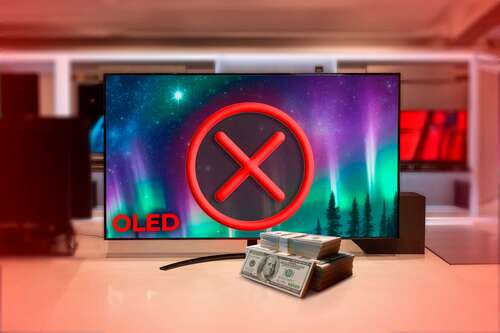
OLED monitors are finally a thing, and you can order one today if you like. They are undoubtedly the pinnacle of image quality and performance for most things you’d want to do on a PC, but I’m still not convinced the time is right to make the leap.
The Obvious Reason: Price
Some people don’t like talking about money, but even they would balk at the asking price for a modern OLED monitor. For example, Samsung’s G85SB QD OLED is a 34-inch, 3440×1440 ultrawide screen that retails for close to $1200 as I write this. For comparison, my 34-inch Dell Ultrawide at the same resolution was only around $500 when I bought it. Right now, a typical 34-inch ultrawide LCD gaming monitor will typically cost between $300 and $500, with $350 seemingly the sweet spot.
There is no doubt that QD-OLED technology is far superior in most ways to any LCD-based monitor, but is it four times as good? Unless you blow your nose with hundred dollar bills, the asking price for OLED monitors is still too high.
I Don’t Want to Be an Early Adopter (Again)
While OLEDs have been in phones, TVs, and even laptops for quite some time now, it’s still a new technology for computer monitors. I was already burned by the first generation of LCD monitors decades ago, so I’m in no hurry to buy early-generation OLED monitors. Heck, I only bought my first OLED TV in 2023, by which time all the most egregious bugs had been worked out. I even hung onto my 720p plasma TV throughout the entire Full HD LCD TV era and jumped straight to 4K HDR. Basically, I’m not in the habit of being the person who pays the most for the worst version of a technology. At least not when it comes to display tech.
I’m Not Convinced the Teething Troubles Are Over
Which brings me to my next reason for being hesitant. One of the main reasons it took so long for OLED technology to make it into monitors is that it simply wasn’t ready for this use case. Phones, TVs, and even laptops don’t have as much static screen-on time as a computer monitor. I know I spend eight hours a day staring at a screen full of mostly static text and UI elements, and personally I’m not convinced that the current generation of OLED screens will hold up well in the medium term. I would love to be wrong, of course, but the only way to actually know is to see how these screens do in the wild. So you can be sure I’ll be combing YouTube to see what the long-term ownership results are for OLED PC monitors.
A Small OLED TV Might Make More Sense
While it’s always been possible to use a TV as a monitor, there have been fundamental differences in the features and performance of these display devices. In many cases, that’s no longer true. If we look at OLED TVs today, you can get 120Hz OLED screens with PC modes, so latency is no issue. Not only do they offer a high refresh rate, but you can get a set with PC features such as NVIDIA G-Sync.
In the past, a 42-inch screen for a monitor might have seemed impractical, but with people using 32″ monitors or 34″ ultrawide monitors these days, it’s no stretch at all. Considering that an OLED TV with these specifications and under 48-inches in size costs less than an OLED monitor, it seems more sensible to use a TV instead. Especially if you’re largely going to use it for gaming or watching media, rather than work. You can always use a standard LCD monitor for work and switch to the OLED TV for play, and probably still come in under budget compared to a “proper” OLED monitor.
It may be worth waiting either way, since in late 2023 LG indicated that smaller OLED TVs are coming making sizes like 32-inch, 34-inch, and 39-inch available for the TV market as well as the monitor market. When this gets into full swing, and panels of these sizes are in full mass production, it will likely bring down the prices of OLED monitors as well.
Once that happens, and you can get a large format OLED monitor for closer to the $500 mark, that’s when I personally would start getting an itchy trigger finger. That, or winning the lottery.

